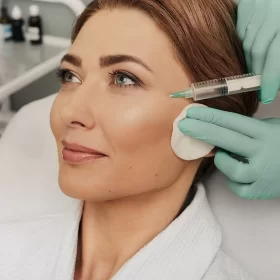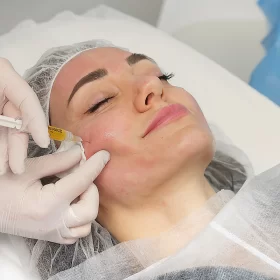Platelet-rich plasma - vampire facelift
Regeneris is an innovative program of bio-stimulation of the skin cells, giving long-lasting effects on regeneration and revitalization of the skin. The goal is to obtain platelet-rich plasma from the patient's own blood, and then injecting it to the skin. Platelet rich plasma can be injected in various ways, using either mesotherapy technique or linearly along the fold or wrinkle of the skin.
WHAT IS PLATELET-RICH PLASMA?
Platelet-rich plasma, also known as PRP, is a concentrate of blood platelets obtained from the patient's blood. PRP therapy is an innovative skin cell biostimulation program that provides long-lasting effects in skin regeneration and revitalization. The procedure involves obtaining platelet-rich plasma from the patient's own blood and then injecting it into the skin. Platelet-rich plasma can be injected in various ways, using the traditional mesotherapy technique or linearly along wrinkles or skin folds. Blood platelets contain growth factors that stimulate regenerative processes in the skin, support collagen production, and accelerate healing processes. In aesthetic medicine, platelet-rich plasma is used to improve skin quality, increase its elasticity and firmness, and reduce fine lines. Treatment with PRP is a natural way to rejuvenate and regenerate the skin, without introducing chemical substances or artificial additives into the body. Due to the presence of growth factors, platelet-rich plasma activates skin cells that start intensive collagen and elastin production – two key components responsible for youthful skin appearance. The effects of the procedure are subtle but long-lasting and completely natural because the regeneration processes occur in line with the body's physiological mechanisms.
Platelet-rich plasma (PRP) treatment
Platelet-rich plasma therapy is a multi-step procedure that begins with the extraction of a small amount of blood from the patient. The blood is then spun down to separate the platelet-rich plasma, which is the active component used during the treatment. Once the plasma is prepared, it is injected into the skin using a thin needle or cannula, a technique that ensures precise delivery of the preparation to the targeted areas.
During the procedure, the patient may experience mild discomfort, and to minimize any unpleasant sensations, local anesthesia such as numbing cream may be used. The procedure is minimally invasive and short, requiring no extended recovery period. Depending on the patient's needs and skin condition, the treatment may be performed as a series of sessions, gradually showing visible results, with the final effect being long-lasting and natural.
One of the significant advantages of this treatment is its versatility - platelet-rich plasma therapy can be used for younger individuals looking to improve skin quality, as well as older individuals wanting to slow down the aging process. The effects of the treatment include improved skin tightness and tone, smoothing of fine lines, as well as reduction of scars and discoloration. This procedure is safe and natural, and through collagen stimulation, the skin gains a healthy and youthful appearance.
VAMPIRE FACIAL EFFECTS
Therapy involving the unique process of obtaining material for the procedure is known as vampire lifting. The patient's blood is drawn and then spun in a special device that separates platelet-rich plasma from the other components of blood. The resulting preparation is then injected into selected areas of the skin to initiate regenerative processes.
Vampire lifting has become synonymous with natural and safe skin rejuvenation. The procedure is exceptionally safe because it utilizes the patient's own cells, minimizing the risk of allergic reactions or complications. The plasma introduced under the skin stimulates cells to undergo intensive renewal, leading to improved skin firmness, reduction of wrinkles and scars, and an overall rejuvenating effect. The procedure is particularly recommended for individuals who, for various reasons, cannot use traditional fillers and for those who prefer natural rejuvenation methods.
The procedure can be applied to the face, face and neck, décolletage, or hands. Thanks to the rejuvenating and regenerating properties of the plasma, the procedure allows for improvement in skin firmness and elasticity, reduction of wrinkles and creases, reduction of scars and discoloration, even out skin tone and texture.
Platelet-rich plasma can also be used on the hair, noticeably regenerating the scalp. Therefore, platelet-rich plasma is used in hair loss therapy. The blood platelets stimulate hair follicles to grow, helping to slow down balding and improve hair condition.
PRICE OF PRP TREATMENT
The cost of a treatment with platelet-rich plasma (PRP) depends on several factors, including the selected treatment area, number of sessions, and individual patient expectations. By choosing a vampire facelift at Ambasada Urody, the patient receives professional care and a guarantee that the procedure will be carried out according to the highest standards. Ambasada Urody clinic prioritizes patient safety and comfort at every stage of the procedure, offering top-quality services. To schedule a consultation and learn about the cost of a PRP treatment, please contact us.

The cell biostimulation program with platelet-rich plasma (PRP) utilizes the body's natural abilities for skin regeneration and renewal. Thanks to the high content of growth factors and stem cells, the therapy intensely stimulates repair processes, improves skin tension, elasticity, and overall skin condition. The method is based on the concept of Autologous Cellular Renewal, which means that the body's own cells are used for revitalization, making the therapy completely safe, natural, and effective. The treatment provides long-lasting rejuvenation effects by supporting skin regeneration at the cellular level.

Angel System is an advanced technology for isolating platelet-rich plasma (PRP), which stands out for significantly higher concentrations of blood platelets and growth factors compared to standard PRP systems. Clinical studies confirm that PRP concentrate with higher concentrations accelerates regenerative processes, providing better results in skin rejuvenation therapy, wrinkle reduction, and stimulation of collagen and elastin production. Thanks to the precise separation technology of Angel System, it delivers the highest quality of plasma, resulting in more effective regeneration and long-lasting treatment effects.

Platelet-rich fibrin (PRF) is a next-generation platelet concentrate, obtained from the patient's blood through collection and centrifugation. It is rich in stem cells and blood platelets, which intensely stimulate tissue regeneration and growth factor production, supporting skin rebuilding and nourishment. The preparation is completely natural, safe, and biocompatible, thus it does not cause allergic reactions or irritations. The use of platelet-rich fibrin allows for long-lasting rejuvenation, improvement of skin firmness, increased elasticity, and acceleration of healing and rebuilding processes, resulting in a healthy, youthful appearance.

The CGF method is the newest and safest therapy in the field of regenerative medicine using stem cells and growth factors obtained from the patient's blood. Thanks to an innovative blood processing process in a specially designed cell separator, we obtain exceptionally highly concentrated plasma containing valuable CD34+ stem cells and concentrated growth factors.

Revolutionary, natural regenerative therapy of a new generation, utilizing isolated microvesicles secreted by the patient's own body cells. Exosomes act as carriers of valuable biological information - containing growth factors, enzymes, microRNAs, and proteins responsible for regeneration, rebuilding, and intercellular communication. Thanks to modern separation technology, it is possible to obtain a highly concentrated exosomal fraction from the patient's own blood, which intensifies the reparative, anti-inflammatory, and anti-aging processes at a cellular level. Exosomes demonstrate significantly stronger and longer regenerative effects than traditional platelet-rich plasma. They stimulate collagen and elastin production, improve skin density, support scar treatment, and inhibit hair loss.
Expert opinion

Vampire facelift is not just one procedure, but a whole group of autologous therapies based on plasma or platelet-rich fibrin. Their goal is to regenerate, rebuild, and stimulate the skin in a completely natural way, using the patient's own resources.
I most often use classic PRP in the therapy of dehydrated, tired skin with early signs of aging. It improves elasticity, color, and overall skin condition without changing its volume.
For more demanding indications such as sagging skin, weakened structure, or scalp therapy, I opt for high-quality PRP, prepared for example in the Angel system. We then obtain a highly concentrated fraction of blood platelets rich in growth factors, which provides a stronger regenerative effect. It works exceptionally well not only in anti-aging therapies but also in cases of hair loss – especially androgenetic and telogen effluvium.
Another option is CGF – plasma rich in growth factors and stem cells, obtained using special separators. It stands out for greater stability and a longer release time of active proteins. I use it primarily where I aim to deeply initiate repair processes – for scars, sagging around the eyes, post-laser treatment regeneration, or as biological support for thread implantation.
Fibrin i-PRF has a gel-like consistency and releases growth factors gradually, ensuring longer and more stable action. It works excellently where the skin is thin and delicate – such as under the eyes. I often use it for significant loss of firmness when I aim for subtle tissue reinforcement and slight lifting with full naturalness. It is also excellent for healing and treating acne-related changes.
Choosing the right type of preparation is key to effectiveness. Plasma and fibrin are safe, proven tools that – with the appropriate protocol – allow for very good results.

